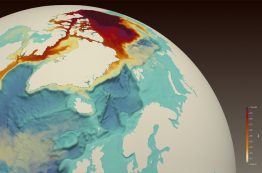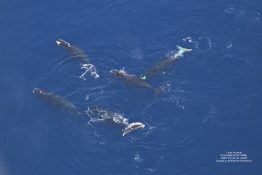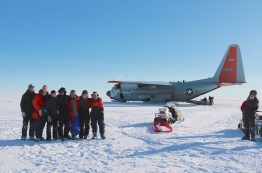The South Pole and the rest of East Antarctica is cold now and was even more frigid during the most recent ice age around 20,000 years ago — but not quite as cold as previously believed. University of Washington glaciologists are co-authors on two papers that analyzed Antarctic ice cores to understand the continent’s air temperatures during the most recent glacial period.
Read more at UW News »Record-high Arctic freshwater will flow through Canadian waters, affecting marine environment and Atlantic ocean currents
Freshwater is accumulating in the Arctic Ocean. The Beaufort Sea, which is the largest Arctic Ocean freshwater reservoir, has increased its freshwater content by 40% over the past two decades. How and where this water will flow into the Atlantic Ocean is important for local and global ocean conditions. A study from the University of Washington, Los Alamos National Laboratory and the National Oceanic and Atmospheric Administration shows that this freshwater travels through the Canadian Archipelago to reach the Labrador Sea, rather than through the wider marine passageways that connect to seas in Northern Europe.
Read more at UW News »A whale murder mystery in the Arctic
From a small aircraft flying over the Pacific Arctic, scientists with the Aerial Surveys of Arctic Marine Mammals (ASAMM) project surveyed the movements and interactions of marine mammals for more than four decades. Observations and images from these surveys offer clues informing our understanding of the lives, and deaths, of marine mammals in this remote region. A new study, published in Polar Biology and led by researchers at the University of Washington’s Cooperative Institute for Climate, Ocean, and Ecosystem Studies (CICOES), is particularly interested in the ‘death’ part of those survey observations, and has uncovered the first direct evidence of killer whales as the primary cause of death for one of the Arctic’s endangered species, bowhead whales of the Bering-Chukchi-Beaufort seas stock.
Read more »NSF-funded deep ice core to be drilled at Hercules Dome, Antarctica
Antarctica’s next deep ice core, drilling down to ice from 130,000 years ago, will be carried out by a multi-institutional U.S. team at Hercules Dome, a location hundreds of miles from today’s coastline and a promising site to provide key evidence about the possible last collapse of the West Antarctic Ice Sheet. The National Science Foundation has funded the roughly five-year, $3 million project involving the University of Washington, the University of New Hampshire, the University of California, Irvine and the University of Minnesota.
Read more at UW News »Some polar bears in far north are getting short-term benefit from thinning ice
A small subpopulation of polar bears lives on what used to be thick, multiyear sea ice far above the Arctic Circle. The roughly 300 to 350 bears in Kane Basin, a frigid channel between Canada’s Ellesmere Island and Greenland, make up about 1-2% of the world’s polar bears. New research shows that Kane Basin polar bears are doing better, on average, in recent years than they were in the 1990s.
Read more at UW News »





